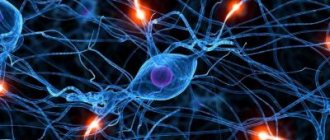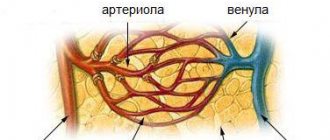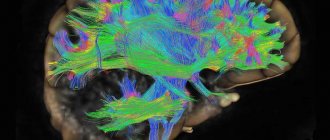Causes
The main reason due to which vertebrobasilar insufficiency develops is stenosis of the main arteries, impaired microcirculation and hemostasis, and microangiopathy. The condition of the extracranial parts of the vertebral arteries worsens.
More often, stenosis appears in the area of the artery at the entrance to the bone canal or directly to the site of formation of the main artery.
Sometimes a violation of cervical circulation occurs due to extravasal compression of the arteries passing through the vertebrae. Stenosis is rarely localized more proximally - in the area of the innominate or subclavian arteries.
Vertebro-basilar insufficiency
The brain is supplied with blood from several arteries. Along the neck, the vertebral and carotid arteries approach the skull.
If blood flow through them is obstructed, and as a result, the corresponding parts of the brain experience oxygen starvation, this condition is called vertebrobasilar insufficiency.
Depending on the affected vessel and the degree of blood flow disturbance, vertebore-basilar insufficiency can be accompanied by different symptoms.
Causes of vertebrobasilar insufficiency
Among the main causes of vertebrobasilar insufficiency are:
- Atherosclerosis. In this disease, the lumen of blood vessels is blocked by cholesterol plaques, disrupting blood flow. Both large and smaller arteries can be affected, and the symptoms of the disease will depend on this.
- Malformations of the arteries. They may not depart from larger vessels quite correctly, be underdeveloped, or have an irregular tortuous course.
- Hypertension, diabetes mellitus and other diseases that are accompanied by impaired circulation in small vessels.
- Compression of the carotid or vertebral artery by incorrectly located muscles, cervical vertebrae in various diseases (osteochondrosis, injuries of the cervical spine, congenital malformations of the vertebrae).
- Increased blood clotting.
- Some types of systemic vasculitis are diseases in which inflammation of the walls of blood vessels develops.
Symptoms of vertebrobasilar insufficiency
The manifestations of the disease are very diverse, depending on how large the artery is affected and how severe the brain damage is. Most common symptoms:
- Attacks of dizziness. They begin suddenly and can last from a few minutes to several hours. It seems to the patient that all surrounding objects are spinning quickly.
- Headaches in the occipital region. They can be dull, pressing or pulsating, and can last for a long time.
- Hearing impairment and tinnitus. At first these manifestations occur in the form of attacks. If there is no treatment, the noise begins to be felt constantly.
- Visual impairment. They may be different. Most often these are sparkling “spots before the eyes.” Double vision is sometimes observed. In more rare cases, an area appears before the patient’s eyes within which he sees nothing.
- Impaired sense of balance and coordination of movements. The gait of a patient with vertebrobasilar insufficiency is uncertain and unsteady.
- Memory impairment. The patient often forgets about all sorts of little things.
- Rapid mood swings, irritability.
- Increased fatigue in the afternoon. After lunch, the patient feels very weak, tired, and drowsy.
What can you do?
Most often, behind vertebrobasilar insufficiency there is an underlying disease that needs treatment. The sooner the cause is determined and proper treatment is started, the easier and more effectively it will be possible to eliminate the symptoms of the disease.
What can a doctor do?
In case of vertebrobasilar insufficiency, the following examination is prescribed:
- Dopplerography and duplex scanning of cerebral vessels. In this case, the doctor can evaluate the blood flow in the cerebral vessels.
- Angiography is an X-ray examination in which a contrast agent is injected into the vessels of the brain. After this, they are well contoured in the pictures.
- Computer and magnetic resonance imaging of the head.
- Rheovasography is a study that helps assess the condition of the blood vessels of the brain.
- Blood chemistry.
Treatment for vertebrobasilar insufficiency depends on its causes. In some cases, medications help well, and sometimes they are ineffective.
Drug treatment may include drugs that improve cerebral blood flow, metabolic processes and nerve cell functions, protect nerve cells from damage, pain relievers, and anti-inflammatory drugs. At the same time, massage, physical therapy, and other treatment methods are prescribed.
In case of significant disturbance of blood flow, which cannot be eliminated with the help of medications, various surgical interventions are used:
- Installation of a stent into the lumen of the artery - a rigid frame that ensures the normal size of the artery lumen and normal blood flow.
- Removal of a large atherosclerotic plaque or large thrombus from a vessel.
- Surgeries on the cervical spine to relieve compression of the arteries.
Found an error? Select it and press Ctrl+Enter.
Source: https://health.mail.ru/disease/vertebro/
Causes of atherosclerosis
Blood flows poorly through the arteries as a result of atherosclerotic lesions, especially:
- the first segment, it is located in the area where the artery begins and enters the canal of the processes of the C5 and C6 vertebrae;
- the fourth segment, located between the zone where the dura mater of the brain perforates and the confluence with the vertebral artery that is located at the beginning of the base of the artery.
It is important to know. These areas are affected against the background of the special geometry of the vessels of the cervical spine, which predisposes to turbulent blood flow and injury to the endothelium in some places.
Vessels are affected by atherosclerotic stenoses, as well as abnormalities in the structure of the vascular bed in newborns.
Treatment
After diagnosing the disease, the doctor selects an effective treatment method. In the early stages of development, the pathology does not show too pronounced symptoms, so outpatient treatment is prescribed.
In case of acute symptoms, the patient must be admitted to a hospital so that the person is under the supervision of specialists, because in this situation a stroke may occur.
It is necessary to treat vertebrobasilar insufficiency comprehensively, that is, taking medications should be combined with physiotherapeutic procedures. There are forms of pathology that are not amenable to drug therapy. To eliminate this variant of the disease, you must first identify the cause of the disease and then prescribe therapy. This will be the key to successful treatment.
In medicine there is no clear and uniform method of treating pathology. The treatment method is selected individually in each specific case.
As treatment with medications, the doctor prescribes:
- vasodilators - as a rule, they start in the fall or spring, at first the dosage is minimal, but gradually the doctor begins to increase the dose (if one drug does not give the desired result, then it is combined with another drug of a similar effect);
- blood thinners - prevent the risk of blood clots;
- nootropic drugs;
- metabolic agents;
- Mexidol;
- Betaserc to reduce dizziness, nausea;
- medications to restore blood pressure.
The patient must be prescribed painkillers, medications for insomnia, sedatives and antiemetics.
The syndrome of diagnosed vertebrobasilar arterial system must be treated in combination with physiotherapeutic procedures.
The following methods are used:
- a course of therapeutic massage - will help restore blood flow;
- physical therapy exercises - will help strengthen the spine, relieve muscle spasms and improve posture;
- manual therapy;
- acupuncture - to relieve spasms;
- use of leeches;
- magnetic therapy;
- use of a neck brace.
If the patient does not get better after complex treatment with medications and physiotherapeutic procedures, the doctor prescribes surgery, but this happens very rarely.
During the operation, blood circulation in the vessels is improved. To do this, angioplasty is performed - a special stent is inserted into the vertebral artery. With its help, the lumen will not narrow, and blood circulation will be normal.
Angioplasty scheme
There are also traditional methods of therapy, but they should be used only in combination with medications. A doctor's permission is required to use them.
For example, you can use:
- vitamin C - found in oranges, cranberries, sea buckthorn, viburnum (eating them can prevent blood clots);
- garlic is a good blood thinner;
- horse chestnut - prevents increased blood clotting.
There are various folk recipes that help with pathology. These are special preparations for hypertensive patients, recipes for vasodilation and many others.
Prescribed therapeutic light exercises should not be combined with heavy exercises and sudden movements. Gymnastic exercises should not cause discomfort; it is better to perform them in the morning. The pace is chosen so that it is not difficult to perform. Breathing should be correct, even, and only through the nose.
Other causes of VBI
The functional functioning of the brain is also impaired due to:
- Microangiopathies Against the background of underlying diseases: diabetes mellitus or arterial hypertension, VBI begins to develop due to damage to small cerebral arteries.
- Infringement of the vertebral arteries The vertebrae of the cervical spine change with spondylosis, osteochondrosis, the formation of large osteophytes and the vessels are affected by compression. Acute compression of the vessel is often noted when turning the head, which reduces blood circulation.
- Extravasal compression of the artery under the clavicle In osteochondrosis, the hypertrophied scalene muscle and altered transverse cervical processes of the vertebrae affect the vessel.
- Acute injury As a result of transport (whiplash-like), iatrogenic (obtained during manual therapy) injuries, sudden movements during gymnastics, cervical circulation is disrupted.
- Inflammation of the vessel wall During arteritis, a defect forms on the vessel wall, then the arteries become dissected: main or vertebral
- Antiphospholipid syndrome It manifests itself with impaired vascular patency and increased formation of blood clots in young people and children.
Risk factors for developing VBI
If a person has a congenital anomaly of vascular development, or osteochondrosis of the cervical spine, this does not mean at all that he will necessarily develop circulatory failure in this pool. But with certain risk factors, the likelihood of this increases.
- Dyslipidemia is increased blood cholesterol and a violation of the lipoprotein ratio.
- Untreated arterial hypertension.
- Increased blood viscosity.
- Diabetes.
- Alcohol abuse.
- Smoking.
- Heart rhythm disturbances.
- Heart valve defects with an increased risk of thrombosis.
Due to dysfunction of the vertebrobasilar arterial system, which supplies blood to the posterior parts of the head - the cerebellum, medulla oblongata, part of the thalamus, hypothalamus, posterior parts of the temporal and occipital lobes, the syndrome develops. One of the main reasons is stenosis (persistent narrowing) of extracranial arteries (external, located on the outside of the skull) - subclavian, vertebral. Other reasons for development:
- Thrombosis. Formation of blood clots that block the vascular lumen.
- Atherosclerotic lesions of vascular walls.
- Fibromuscular dysplasia, causing vascular deformations - aneurysms, stenosis.
- Compression of the vertebral arteries associated with diseases such as osteochondrosis, herniated disc, spondylosis, osteophytes (bone growths) in the spine.
- Muscle spasm in the neck area.
- Dislocation of the vertebrae.
- Abnormal shape and location of arteries and veins (arterial dissection, aplasia - developmental defects, malformation - improper connection of elements of the circulatory system with each other) located in the basilar basin.
- Inflammatory processes (Takayasu's disease, vasculitis, arthritis).
Other causes: myelopathy (impaired conduction of spinal cord structures), injuries to the head and neck, vertebral instability. Arterial hypertension, diabetes mellitus and excess weight are provoking factors. Statistics show that cerebral infarctions that occurred against the background of vertebrobasilar insufficiency syndrome developed in 43% of patients due to blockage of the lumen of the main arteries, in 20% due to cerebral embolism (a blood clot in the circulatory system of the brain), in 19% due to cardiogenic embolism ( thrombus in the atrium circulatory system).
In 18% of patients, violations occurred due to blockage of small vessels. One of the characteristic signs of vertebrobasilar syndrome is hemianopsia (blindness in half of the visual field), which developed in 96% of cases as a result of occlusion (blockage) of the posterior cerebral artery. Vertebrobasilar disease in 10% of cases is accompanied by local cerebral hemorrhage.
The pathogenesis of both TIA and VBI is essentially similar to the pathology of ischemic (lacunar, hemorrhagic) stroke. The causes of vertebrobasilar insufficiency are atherosclerosis of large vessels (31%), small vessel diseases (16%), intra-arterial embolism (17%), cardiac embolism (27%) and various rare factors (9%).
The disease can affect not only adult women and men, but also representatives of the pediatric population. VBI in children can develop as a result of congenital pathologies of the vertebral or basilar arteries. Often the causes include injuries to the child’s spine during sports training or gymnastics. A relatively common cause is birth trauma to the spine.
The most common atherosclerotic vascular lesions are located at the beginning of the vertebral arteries, the intracranial part of the vertebral arteries, the proximal and middle part of the basilar artery, the proximal part of a. cerebri posterior. Smaller branches (eg, AICA, PICA) are affected by atherosclerosis more often than larger branches.
The involvement of perforating small arterioles (50-200 µm in diameter) differs from the process of atherosclerosis. The process is known as lipohyalinosis and is commonly associated with hypertension. Due to the anatomy of these small arterioles, the consequence of their occlusion is small single or multiple trigeminal infarctions.
Stenotic changes in the vertebrobasilar region can cause complications arising through a hemodynamic mechanism. These are short, stereotypical and, above all, orthodox TIAs. The actual deficit varies greatly depending on how long it takes before full blood flow is restored.
In addition to these reasons, the disease can develop with cervical osteochondrosis, spondylosis, mechanical compression of a. vertebralis, especially within C1-2 in lateral tilt and head rotation. Tilt and rotation (or in combination) pose a risk, especially in older patients, as a result of compression of the artery a.
A less common cause of vertebrobasilar insufficiency may be subclavian steal syndrome. It develops due to stenosis or occlusion of the beginning of a. subclavia (before the indentation a. vertebralis). During physical activity of the upper limb on the affected side, limb fatigue and pain occur due to ischemia.
At the same time, a reverse flow of blood occurs in a. vertebralis, therefore, arterial blood is actually removed from the brain (steal = steal, theft). The combination of pain in the upper limb with simultaneous dizziness or headaches is an indirect reason for suspecting the development of subclavian steal syndrome.
A rare cause of vertebrobasilar insufficiency is a dissection of the vertebral artery (similar to an aneurysm), usually starting in the middle layer of the vessel wall. The dissection leads to the formation of an intramural hematoma, spreading along the vascular wall, which can create a false flow channel or compression of the lumen of the vessels.
Cerebral ischemia with VBI
Cerebral ischemia with VBI appears against the background of VBI as a result of additional factors in which:
- properties change, microcirculation is disrupted and the formation of blood clots increases;
- cardiogenic embolism is detected;
- due to a loose thrombus, several small arterio-arterial embolisms occur on the wall;
- a blood clot forms on the wall.
Due to the forced stay of the head in an uncomfortable position for a long time, especially in the presence of osteochondrosis, thrombosis increases.
According to studies, with VBI, changes occur in brain tissue: the occipital lobe cortex, cerebellum, brain stem, and pons.
Important. The variety of causes of VBI in a child or adult requires a thorough search for them in each individual case.
Consequences of VBN
One of the most severe consequences of vascular insufficiency is stroke. If the pathology is not treated, then in approximately a third of all cases such a sad ending occurs. And statistics of patients with cervical osteochondrosis indicate a third of patients who are diagnosed with vascular insufficiency syndrome. The need for timely consultation with a doctor becomes clear.
Stroke may be a complication of VBI
The danger is that the symptoms of the disease (tinnitus, dizziness, nausea, etc.) appear periodically and then disappear. A person does not pay due attention to symptoms, considers them to be situational ailments and allows the disease to progress. Sometimes the only way to save the situation is through surgery.
Constant signs
Persistent symptoms tend to increase with the progression of the disease and provoke several ischemic attacks, which ends in vertebrobasilar stroke in children or adults.
Persistent symptoms of VBI are recognized by the presence of:
- acute pain in the back of the head;
- weakness and fatigue;
- paroxysmal dizziness and fainting;
- nausea, discomfort in the throat;
- ringing in the ears and hearing loss;
- weakening of memory and attention;
- decreased vision, blurred images, “bright spots” before the eyes, diplopia;
- tachycardia and irritability;
- heat in the head, face and hands;
- increased sweating.
Clinical picture of vascular insufficiency
The clinical picture (symptoms) that occurs with ischemia of the vertebrobasilar region can be very diverse. A common symptom is dizziness, which is often accompanied by nausea and vomiting. Vertigo is a phenomenon that is the initial symptom in approximately half of all cases when spinal circulation is disrupted.
- visual impairment;
- diplopia;
- blurred vision;
- unilateral and bilateral homonymous hemianopsia;
- dysarthria;
- dysphagia;
- paresthesia - mild paralysis, numbness in the face;
- various combinations of weakness or lack of sensation in the legs.
Vertebro-basilar insufficiency, the symptoms of which often alternate, can only manifest as vertigo, which can occur as an isolated symptom. Long periods of relapses (more than 6 months) with dizziness without other accompaniments are not typical for VBI. Tinnitus and hearing loss are not common symptoms.
In approximately 40% of cases, attacks of vertebrobasilar insufficiency last more than 1 hour, although patients themselves often indicate a duration of several minutes. About 90% of TIAs last less than 2 hours. The difference between the 2 conditions is that VBI usually has a shorter duration than carotid TIA. The severity of symptoms is highly variable, ranging from mild to severe. The frequency of attacks varies from single attacks to multiple attacks throughout the day.
The condition of vertebrobasilar insufficiency is a combination of symptoms. According to one study group, 43% of patients had vertigo, 60% had ataxia, 39% had diplopia, 27% had dysarthria, and 37% had blurred vision. Manifestations may vary depending on the damage to the extra- or intracranial part. Damage to the extracranial vertebral part, mainly, there is dizziness, blurred vision, imbalance, involvement of the intracranial part is characterized only by vertigo. TIA due to basilar artery disease usually has 2 or more of the following symptoms:
- dizziness;
- slurred speech;
- double vision;
- dysphagia;
- unilateral or bilateral limb weakness.
With vertebrobasilar insufficiency, sudden short-term loss of muscle tone (drop attacks) may occur; the patient, while conscious, suddenly falls (mostly to his knees). With more severe damage, loss of consciousness occurs - syncope.
When examining patients, it is important to correlate subjective symptoms with objective neurological signs of the vertebrobasilar territory. Common and important objective findings include:
- nystagmus;
- oculomotor disorders;
- Horner's syndrome (ptosis and meiosis, sometimes anhidrosis on the affected side);
- numbness and impaired motor skills in the face and limbs;
- speech and coordination disorders.
Examination of posture and gait is important. In patients, only one symptom is indicated as a subjective sign, for example, vertigo; with an objective study, other manifestations are determined, in particular, ataxia of the limbs or trunk. For localized lesions, variable (crossed) syndromes are typical, when on the affected side - ipsilateral - there is a failure of the cranial nerve nucleus, Horner's syndrome or cerebellar syndrome, and on the contralateral side hemiparesis or hemihypesthesia is formed. Vertebro-basilar insufficiency is characterized by any combination of weakness, paresthesia, numbness of the upper and lower extremities, and face.
Temporary symptoms
Symptoms of a temporary nature have varying durations (from several hours to a day) and appear during so-called transient ischemic attacks, which are a transient acute disorder of cerebral circulation.
The main features of this group:
- pressing pain in the back of the head;
- feeling of constant discomfort in the cervical spine;
- dizziness.
Symptoms of a permanent nature tend to increase as the disease progresses and can provoke ischemic attacks, in which there is a threat of vertebrobasilar stroke.
Main permanent symptoms of VBI:
- headaches of a pressing or pulsating nature localized in the back of the head;
- dizziness (occurs in paroxysms, and when severe can lead to fainting);
- nausea;
- hearing loss;
- noise in ears;
- weakening of concentration and memory;
- absent-mindedness;
- blurred vision;
- blurred image, presence of fog or spots before the eyes, diplopia (split objects) is also possible;
- weakness (especially in the afternoon);
- fatigue;
- irritability;
- increased sweating;
- heat in the head, hands, face;
- tachycardia;
- sensation of a foreign object in the throat, soreness.
https://www.youtube.com/watch?v=4FYcojnAlsU
Progression of the disease leads to the manifestation of additional symptoms:
- difficulty swallowing;
- speech impairment due to numbness in the mouth area;
- hallucinations;
- loss of vision;
- sudden falls (so-called drop attacks);
- ischemic strokes.
Previously, experts believed that vertebrobasilar insufficiency was exclusively a disease of adulthood. However, it later became clear that the pathology can also affect children of all ages, starting from 3 years old.
Parents should be alert to the following signs:
- fast fatiguability;
- frequent crying or restlessness;
- drowsiness;
- poor posture;
- intolerance to stuffiness, which provokes severe dizziness to the point of fainting.
Vertebro-basilar insufficiency syndrome affects the oxygen supply to the brain, since vascular spasm worsens the blood supply to the brain. Based on this, it is very important to pay attention to such a symptom of VBI as dizziness. And if it is accompanied by additional ailments, you should consult a doctor. These include:
- throbbing pain in the head, accompanied by nausea. This situation often happens after waking up;
- short-term loss of orientation in space, unsteady gait;
- frequent loss of balance;
- visual disturbances due to tinnitus;
- unmotivated increases in blood pressure;
- numbness of the facial muscles and tongue.
Symptoms of VBI include nausea, dizziness, and tinnitus.
The table below discusses the symptoms of VBI, the pathologies that accompany it, and the frequency of their occurrence in 129 patients.
| Symptom | Number of patients (abs.) | Number of patients (rel.,%) |
| Dizziness (systemic, non-systemic) | 129 | 100 |
| Neurological manifestations of osteochondrosis of the cervical spine | 129 | 100 |
| Headache (mainly in the back of the head) | 76 | 58.9 |
| Feeling of heaviness in the head and neck | 22 | 17.1 |
| Tinnitus, decreased hearing acuity | 52 | 40.3 |
| Vision-related disorders | 57 | 44.2 |
| Symptoms of focal damage to the nervous system | 62 | 48.1 |
| Spontaneous nystagmus | 3 | 2.3 |
| Degenerative changes (osteochondrosis) of the cervical spine | 121 | 93.8 |
| Fainting | 2 | 1.6 |
| Kimmerle anomaly | 6 | 4.7 |
| Dysfunction of suprasegmental vegetative formations | 118 | 91.5 |
Recognizing the symptoms of pathology in children
Vertebro-basilar insufficiency syndrome affects children from 3 years of age due to congenital anomalies of the vertebral or basilar arteries and trauma. Parents should be on the lookout for symptoms indicating the following:
- lethargy and fatigue;
- causeless restlessness with frequent crying;
- the appearance of postural disorders;
- frequent daytime naps;
- inability to stay in a stuffy room;
- attacks of dizziness, often with fainting.
Dizziness occurs because the vestibular system is sensitive to a lack of blood supply to the brain.
Symptoms and signs of the disease
In neurology, manifestations of clinical signs of vertebrobasilar syndrome include:
- frequent headaches in the back of the head, throbbing or pressing;
- attacks of dizziness, which as the disease progresses lead to fainting, worsen after prolonged neck immobility (sleep, sedentary work), and are sometimes accompanied by nausea;
- clearly manifested discomfort, a feeling of numbness in the neck;
- the appearance of tinnitus, which becomes constant as the disease progresses;
- visual disturbances: blurred contours, fog or spots before the eyes;
- imbalance, unsteadiness when walking.
To prevent acquired vertebrobasilar syndrome from spoiling the quality of life, the general recommendation for each person is to adhere to a physical activity regime and use a special warm-up. Gymnastics for the prevention of VBI disease is performed smoothly, without tension. It is good to do exercises in the morning after sleep, slowly warming up. Periodically take courses in relaxing massage and physiotherapy.
The most dangerous poses for gymnastics for patients with vertebrobasilar syndrome are the head thrown back, lying on the stomach (and you can’t sleep like that with this disease) and circular rotations of the head with a large amplitude. Effective exercises to reduce the manifestations of the disease are warm-ups with bending and stretching the head. Each exercise must be repeated 10 times, then move on to the next one. This is the complex:
- tilting your head forward, reach your chin to your chest, after a few seconds return to the original position;
- tilt your head to the right and left, reaching your shoulder;
- slowly rotate your head in a circle, first in one direction, then in the other direction;
- pull your head forward slowly, then return to the starting position;
- Pull your head up, fix the position of your head for a few seconds, relax.
After this, use the complex to warm up the whole body, also repeating the exercises 10 times:
- turn your body to the right and left, stretching in the direction of the turn;
- standing straight, raise your arms with your palms together and hold in this position for a short time;
- stand on one leg for as long as possible, change legs.
With vertebrobasilar arterial insufficiency syndrome, spasms are created in the intervertebral vessels, which impairs the nutrition of the basilar artery. Subsequently, the brain receives inadequate nutrition, and a variety of functional nervous disorders may develop.
Osteochondrosis is one of the main risk factors. Degenerative changes in the vertebrae caused by the disease impair blood supply to the brain. Unfortunately, the disease can be diagnosed at different ages.
The main risk factor for the development of VBI is neck osteochondrosis
Diagnosis confirmation
Diagnosis of VBI is aimed at a neurological examination to find out the underlying pathology in which it develops. Due to the variety of manifestations and the presence of similar signs in other diseases, the diagnosis of VBI becomes quite complex. To confirm circulatory failure, functional and de Klein tests are used. To confirm the diagnosis, turn the head in different directions and throw it back.
Perform hardware diagnostics:
- transcranial dopplerography, which evaluates the state of cerebral blood circulation;
- magnetic resonance angiography. It helps to examine the affected vessels in the vertebrobasilar region, to find out their length, extent and nature;
- computed spiral angiography. It is prescribed to visualize the lumen in the vessels and their walls;
- digital subtraction arteriography, through which the lumen in the vessels is visualized;
- rheoencephalography - to study cerebral blood circulation.
Diagnosis is carried out using neuropsychological tests to assess the patient's condition.
Diagnostics
To confirm the diagnosis of vertebral basilar insufficiency, it is necessary to exclude diseases that are similar in symptoms to VBI. The doctor will have to do serious work with the patient in order to separate the patient’s subjective assessments from objective changes.
Instrumental diagnostic methods are used as the main measures to identify vertebrobasilar insufficiency. They allow not only to confirm the diagnosis, but also to identify the causes of the pathology. These include:
- Doppler ultrasound of the vessels of the neck and head, which reveals abnormal slowing of blood flow and reveals vascular occlusions;
- X-ray examination of the vessels of the head and neck (angiography) or MR angiography, which allows you to assess the condition of the arteries, determine the width of their lumen, and identify narrowings or aneurysms;
- X-ray examination of the brain (rheoencephalography), which allows you to evaluate the functioning and blood supply of the brain;
- radiography of the thoracic and cervical spine, which reveals spondylogenic sources of blood supply disturbances;
- computer or magnetic resonance imaging of the spine, through which pathologies of the spine, intervertebral discs and soft tissues are identified.
To differentiate vertebrobasilar insufficiency, the doctor performs a series of functional tests that identify concomitant vascular pathologies, heart problems and neurological disorders.
Do not try to independently determine the cause of ailments that may be a sign of the development of VBI. Only a comprehensive differentiated examination will help make an accurate diagnosis, on the basis of which the doctor will prescribe treatment.
Use of medications
VBI treatment is performed:
- Vasodilators (drugs that dilate blood vessels) Treatment is prescribed for the purpose of vascular patency in osteochondrosis, spondylosis, spondylolisthesis in the spring and autumn seasons. Small doses are gradually increased. If the effect of one type of drug is insignificant, additional similar drugs are prescribed. Treatment begins with diuretics, ACE inhibitors (Captopril, Enelapril), calcium channel blockers (Amlodipine, Felodipine), beta blockers (Antenol, Metopropol, Bisopropol). If the pressure does not decrease, treatment is carried out with complex therapy (diuretic + ACE inhibitor, diuretic + b-blocker, beta blocker + calcium channel blocker).
- Antiplatelet agents to reduce blood clotting These drugs prevent the formation of blood clots. Treatment is carried out with acetylsalicylic acid (aspirin). It should not be taken on an empty stomach or against the background of diseases of the digestive system. Clopidogrel, Dipyridamole or Ticlopidine may be prescribed instead of aspirin. The optimal therapeutic dose of aspirin is 0.5-1.0 mg/kg/day.
- Metabolic and nootropic drugs Treatment with these drugs (Glycine, Piracetam, Actovegin, Cerebrolysin, Seamax, Nicergoline) improves the functional functioning of the brain.
Drugs to eliminate blood pressure and other symptoms are prescribed individually. Folk remedies are prescribed in general complex therapy. The drug Bilobil from the Gingko biloba plant is effective. Treatment with berries rich in vitamin C: cranberries, viburnum, sea buckthorn, lemons, oranges, kiwi, currants, and garlic thins the blood. Treatment with horse chestnut tincture reduces blood clotting.
Hypertension sufferers will be helped by folk remedies from the following collections:
- Steam lemon balm (20 g), corn silk (40 g) with boiling water and add lemon juice (1 lemon). After an hour, take 0.5 tbsp. half an hour before meals. After a week's course, take the same break.
- Make a mixture of rue, corn silk, mint and valerian in equal parts by weight. Place in a jar for storage. Pour boiling water (1 tbsp.) – 1 tbsp. l. collection and let it brew for 30 minutes. Before meals, drink a third of a glass for a course of 30 days.
Treatment of VBI syndrome
If we analyze the main causes that cause vascular insufficiency syndrome, we get the following list:
- degenerative-dystrophic changes in the vertebrae associated with osteochondrosis;
- clamping of blood vessels by intervertebral hernias, growths on bones, tumors;
- blood clots in blood vessels;
- muscle spasms are consequences of cervical osteochondrosis.
In addition to the above reasons, an incorrect lifestyle has a negative impact on a person’s condition. The habit of moving little and sedentary work often form the prerequisites for spinal curvature. Any deviation in the structure of the ridge can contribute to vascular spasms. Risk factors include tobacco and alcohol use and poor diet. All factors together form the prerequisites for vascular insufficiency syndrome.
If a diagnosis of VBI is made, then the presence of osteochondrosis worsens the situation. When treating, first of all, attention is paid to treating the cause, for example, osteochondrosis or hernia. Symptoms of vascular insufficiency will disappear automatically when the root cause is eliminated.
A sedentary lifestyle often causes the development of VBI
The modern pace of life, the lack of nutritional culture, the habit of a sedentary lifestyle have led to the fact that osteochondrosis has become “younger”. Previously, this diagnosis was made after 40 years, but now, unfortunately, a huge number of young people also suffer from this pathology. To the list of reasons it is also necessary to add a complete lack of physical activity, genetic predisposition, injuries ever received, and inability to overcome stressful situations.
If not treated promptly, the consequences can be very serious. If you suspect vascular insufficiency, you should immediately consult a doctor.
Treatment of VBI comes down to eliminating the root cause, namely osteochondrosis. It is recommended to perform it in a hospital setting, although home treatment is also possible. However, in a hospital setting, treatment can always be adjusted for additional indications. If you are being treated at home, you must regularly come for consultations with your doctor.
Treatment of VBI should begin with eliminating the underlying cause.
Treatment uses medications and massage with physical therapy. Tablets are ineffective without physiotherapy. It must be remembered that restoring full blood flow in the arteries of the neck is a key task in the treatment of VBI syndrome, and with the help of tablets you can only achieve relief from pain and inflammation.
Treatment with drugs
The main goal of drug treatment for vascular insufficiency syndrome is to eliminate pain, nausea or other unpleasant symptoms. As a rule, they start with anti-inflammatory non-steroidal drugs such as ibuprofen, diclofenac or the like, and then add other drugs based on symptoms.
For osteochondrosis and vascular insufficiency, several drugs are usually used at once, and only a doctor can prescribe them. It is forbidden to do this yourself - the risk of error is very high.
As a rule, the following are prescribed along with NSAIDs:
- vasodilators;
- painkillers, analgesics;
- vitamins;
- antiplatelet agents - to prevent the formation of blood clots;
- drugs that normalize blood pressure;
- neurometabolic stimulants to improve mental performance;
- drugs that improve oxygen absorption;
- when indicated: antidepressants and sleeping pills.
The drugs will relieve pain and inflammation
If any of the symptoms are particularly disturbing, then the doctor in this case selects symptomatic treatment individually.
Massage
To restore full blood flow in the vessels of the neck, as well as to relieve muscle tension, massage is recommended for patients with osteochondrosis. You can use different techniques, ranging from conventional manual massage in a medical institution to acupuncture. It all depends on the person’s health status, medical indications and financial capabilities of the patient.
Therapeutic exercise is one of the most effective ways to prevent and treat cervical osteochondrosis. A specialist will tell you what exercises to do. It is important that the condition does not worsen when doing exercises. Discomfort and pain indicate that this exercise should be stopped and additional consultation with a doctor. Perhaps the patient is doing it too hard and just needs to slow down. In general, there are several recommendations for performing exercises.
- Exercises are performed smoothly, without sudden movements.
- Start with a comfortable number of repetitions. The load is increased gradually.
- The best time to perform a set of exercises is in the first half of the day, ideally in the morning.
- After physical exercise, water procedures are recommended. For example, a contrast shower.
- After a set of exercises, you can do a self-massage of the neck, back of the head, and collar area.
- Breathing should be calm.
- When performing exercises, maintain a straight posture.
Exercise therapy is incredibly important in the treatment of vertebrobasilar insufficiency and osteochondrosis of the neck
When performing almost all exercises, the starting position is standing, feet shoulder-width apart. When the patient's condition is serious, they can be performed while sitting on a rigid support. Recommended exercises for cervical osteochondrosis.
- Tilts of the head followed by fixation for 3-5 seconds in extreme positions. Perform for 2-3 minutes.
- Similar bends to the side. When performing this, the patient pulls the ear towards the shoulder - not vice versa. Perform for 2-3 minutes.
- Circular rotations of the head left and right. They start by stretching the chin to the chest, and then towards the shoulder. Then they tilt their head back and also pull it towards their shoulders. Then they switch to full circular rotations. This exercise must be performed very carefully - if performed incorrectly or quickly, there is a huge risk of injury. If you feel pain or discomfort, stop the exercise immediately. Perform for 2-3 minutes.
- Pulling the head forward. It is performed in this way: the head seems to move forward in relation to the spine. Repeat for 1-2 minutes.
- Slow body turns. Performed only by the upper half of the body. The legs and pelvis remain in place. 8 times in each direction.
- The arms are spread to the sides with a slow rise upward. The arms are straightened above the head, the palms are joined. You need to fixate in this position for 10-15 seconds.
- Movements with a straight leg back and forth. Performed alternately with each leg. The supporting leg is straight. Perform 10 times on each leg.
- Maintaining balance. Starting position - standing on one leg, the other foot pressed to the inside of the shin or knee. The fingers stretch upward and join together. In severe conditions, it is performed with support - for example, on a chair.
- Plank. The exercise has more than ten different variations. In case of vascular insufficiency, it is recommended to do this: you need to lie on your stomach, fold your arms so that your palms are directed parallel to the spine upward. In the legs, emphasis is placed on the toes. From this position, straighten your arms, raise your torso, and hold this position for 30 seconds. If the exercise is difficult, then 10-15 seconds.
Exercises should be performed gradually, without straining the body too much. If you feel a surge of strength and energy, you can gradually increase the load. In the first period, the complex is performed 2-3 times a week, and later – daily.
Surgical interventions
In severe cases (with osteochondrosis, spondylosis), insufficient blood circulation (with a reduction in the diameter of the arteries) due to compression, stenosis, spasms is eliminated by operations:
- microdisectomy, which stabilizes the spine in the cervical region with osteochondrosis;
- endarterectomy removes atherosclerotic plaques from the lining of the arteries;
- laser reconstruction of intervertebral discs for osteochondrosis;
- angioplasty - insertion of a special stent to widen the vessel and maintain blood flow to the brain.
Vertebrobasilar insufficiency - what is it? Forms of the disease
A neurological disease such as vertebrobasilar insufficiency is inextricably linked with vascular abnormalities.
The pathology is an acute lack of oxygen and nutrients in the tissues of the brain, and the source of the problems is compression or obstruction of the main vessels located in the upper part of the spine, neck and at the base of the skull.
The prognosis for vertebrobasilar insufficiency (abbreviated VBI) depends on the response of the patient and the doctor to the identified disease: the more timely treatment is started, and the more strictly the recommendations of specialists are followed, the higher the chance of containing the pathology and preventing it from progressing.
Causes
The main cause of dysfunction of the blood supply to the brain in vertebrobasilar insufficiency is deterioration in the patency of the vertebral or basilar artery. In some cases, both vessels undergo changes.
However, regardless of which part of the circulatory system fails to cope with the tasks assigned to it, the disease is accompanied by a standard set of neurological disorders.
Identifying the causes of vertebrobasilar insufficiency syndrome is an important part of the diagnosis, which allows you to select the most effective treatment methods.
Congenital causes
Congenital forms of vertebrobasilar insufficiency are extremely rare and have the most severe consequences. It may be based on various pathologies of a genetic, anatomical, and sometimes traumatic nature.
Among the most common causes of congenital vertebral-basilar insufficiency, doctors call:
- disorders that occurred in utero - fetal hypoxia, incorrect position of the neck and head of the unborn baby during multiple pregnancies;
- genetic abnormalities - arterial hypoplasia and fibromuscular dysplasia, Kimmerly syndrome, additional (cervical) ribs, pathological tortuosity of the arteries;
- disorders that occurred during childbirth - compression or dislocation of the cervical vertebrae, other injuries.
The most severe consequences are caused by vertebral-basilar insufficiency, which appeared in utero or was obtained as a result of the passage of the fetus through the birth canal.
Such pathologies are not detected immediately, and any delay in treatment is fraught with complications.
Genetic anomalies of the vertebral vein and basilar artery can be predicted even before the baby is born based on the results of special tests and ultrasound.
Acquired reasons
The acquired form of VBI occurs 3-4 times more often than the congenital form. With this type, the disease occurs against the background of primary pathologies of a systemic or local nature:
- for cervical osteochondrosis, spondyloarthrosis and spondylosis;
- with a herniated disc in the cervical spine;
- with hypertrophy of the scalene muscle;
- for diseases of the vascular walls - stenosis of the basilar artery or vertebral vein, arteritis, dissection, etc.;
- for thrombosis of arteries and veins, antiphospholipid syndrome, atherosclerosis.
Also, the cause of persistent disruption of blood microcirculation in the brain can be systemic diseases: diabetes mellitus, arterial hypertension.
In isolated cases, VBI develops after neck and head injuries during a car accident or when performing sports exercises unsuccessfully.
Symptoms
The range of symptoms associated with VBI is extensive, often similar to diseases of the ENT organs, vision, and musculoskeletal system. Their intensity varies from mild dizziness in a chronic course to serious transient ischemic attacks in an acute attack.
There are differences in the manifestations of the disease depending on its causes. For example, the symptoms of vertebral basilar insufficiency against the background of cervical osteochondrosis are of a constant, slowly progressive nature, while the disease caused by thrombosis begins suddenly, and its symptoms reach a peak almost instantly.
Acute
Symptoms of acute vertebrobasilar insufficiency appear suddenly and are severe from the very beginning. The main manifestations of this type of disease are:
- drop attacks - sudden loss of balance, falling, inability to navigate in space (be aware of the true position of the body);
- transient ischemic attacks - sudden paralysis of various muscle groups, their complete relaxation, inability to speak, move, swallow, control urination, etc.;
- intense dizziness, which is accompanied by nausea.
Often, before the onset of an acute attack of VBI, patients feel compression in the back of the head, a dull headache that does not go away after taking medications, and a feeling of discomfort in the neck (pain, pressure).
Chronic
When chronic, vertebrobasilar insufficiency develops slowly, and at first its symptoms are not taken seriously. The following may indicate the development of pathology:
- frequent headaches localized in the back of the head;
- hissing or clicking in the ears, sounds reminiscent of cars passing on the freeway;
- visual disturbances - blurring or loss of objects, floaters, fog and split images;
- fast fatiguability;
- irritability, mood swings;
- tachycardia, slight shortness of breath, feeling of heat throughout the body.
As the chronic form of VBI develops, it is accompanied by an increase in the listed symptoms.
Visual impairment results in blindness, tinnitus results in deafness, fatigue results in complete loss of performance and serious problems with thinking.
If the problems are ignored, the chronic syndrome of insufficiency of cerebral blood supply turns into an acute attack: ischemic attack, stroke, dementia.
Spondylogenic
In cases of spinal disease that provoke vertobasilar insufficiency, the symptoms are short-term in nature and worsen with certain movements or prolonged stay in specific positions. This type of pathology is expressed by the following symptoms:
- acute headache;
- spots and spots before the eyes;
- dizziness;
- fainting.
With progression, these signs can be supplemented by syndromes characteristic of the chronic form of VBI.
Diagnostics
To confirm the diagnosis of vertebral basilar insufficiency, it is necessary to exclude diseases that are similar in symptoms to VBI. The doctor will have to do serious work with the patient in order to separate the patient’s subjective assessments from objective changes.
Instrumental diagnostic methods are used as the main measures to identify vertebrobasilar insufficiency. They allow not only to confirm the diagnosis, but also to identify the causes of the pathology. These include:
- Doppler ultrasound of the vessels of the neck and head, which reveals abnormal slowing of blood flow and reveals vascular occlusions;
- X-ray examination of the vessels of the head and neck (angiography) or MR angiography, which allows you to assess the condition of the arteries, determine the width of their lumen, and identify narrowings or aneurysms;
- X-ray examination of the brain (rheoencephalography), which allows you to evaluate the functioning and blood supply of the brain;
- radiography of the thoracic and cervical spine, which reveals spondylogenic sources of blood supply disturbances;
- computer or magnetic resonance imaging of the spine, through which pathologies of the spine, intervertebral discs and soft tissues are identified.
To differentiate vertebrobasilar insufficiency, the doctor performs a series of functional tests that identify concomitant vascular pathologies, heart problems and neurological disorders.
Do not try to independently determine the cause of ailments that may be a sign of the development of VBI. Only a comprehensive differentiated examination will help make an accurate diagnosis, on the basis of which the doctor will prescribe treatment.
Treatment methods
Treatment for vertebral basilar insufficiency depends on the degree of brain damage and the causes of the disease. In the chronic course of the pathology, measures are taken to restrain the progress of the disease. They are predominantly conservative in nature and do not require hospitalization of the patient. The basis of treatment is medications:
- drugs to dilate blood vessels and improve blood flow through them;
- drugs for the prevention of blood clots based on warfarin or aspirin;
- drugs to restore metabolic processes in brain tissue, that is, nootropics - Actovegin, Glycine, etc.;
- drugs for stabilizing blood pressure - Betaserc, Anaprilin and their analogues.
It is also important to remember that the symptoms and treatment of VBI are inextricably interconnected, so it may be necessary to take individually selected medications: anti-inflammatory and analgesics, sedatives and antidepressants, antiemetics and hypnotics.
Any medications, even over-the-counter ones, are prescribed by a doctor only after a detailed examination and assessment of the patient’s health for possible contraindications!
When an acute attack of vertebrobasilar insufficiency occurs, standard clinical recommendations for patients requiring urgent medical care are applied. Since this form of the disease has a high probability of complications, the patient is treated in a specialized hospital or intensive care unit.
They, unlike patients with a chronic form of the pathology, are prescribed drugs not in oral form, but in the form of solutions for intravenous and intramuscular infusion.
Conservative treatment of vertebrobasilar insufficiency is supplemented with physical therapy, and in especially severe cases, surgical intervention is performed to restore blood flow: angioplasty to restore blood flow in the arteries, endarterectomy to remove a blood clot, microdiscectomy to remove the protruding part of the intervertebral disc compressing the vessel.
Complications
Vertebrobasilar disease becomes more complicated in the absence of timely diagnosis and comprehensive treatment.
The patient's condition can be complicated by almost continuous transient ischemic attacks, acute ischemic stroke, and severe dyscirculatory encephalopathy.
All these complications lead to irreversible mental disorders, loss of self-care abilities, and rapid progression of dementia.
Prevention
To prevent complications, it is important to strictly follow the recommendations of your doctor, take prescribed medications, regularly undergo medical examinations and change your lifestyle. The development of the disease can be stopped by:
- a diet aimed at reducing blood cholesterol levels, strengthening bone and cartilage tissue, providing the nervous system with essential nutrients and strengthening vascular walls;
- physical activity and exercise therapy, which can strengthen the muscle corset and improve microcirculation in the problem area;
- daily blood pressure monitoring;
- sleep on an orthopedic mattress and pillow, selected individually;
- wearing a neck brace during periods of exacerbation of symptoms;
- daily long walks in the fresh air and swimming.
As for the prevention of primary diseases that provoke the development of VBI, attention should be paid to creating a strong and resilient muscle corset along the entire spinal column.
A diet rich in collagens, minerals and trace elements will help strengthen not only the spine, but also the cardiovascular system.
Even minor injuries to the neck and back should not be ignored; osteochondrosis and other diseases of the musculoskeletal system should be treated in a timely manner.
Source: https://bloodvessel.ru/prochee/vertebro-bazilyarnaya-nedostatochnost
Establishing diagnosis
Making an accurate diagnosis is very problematic, this is due to the fact that the symptoms of VBI syndrome do not differ in any specific indicators from a number of other diseases. The diagnosis is based on a thorough study of the history of the disease and patient complaints.
A full instrumental and physical examination is carried out. The main examination method is Doppler ultrasound. It is necessary to assess the speed of arterial blood flow in the neck and head. The method is completely painless. The arteries of the spine are also subject to detailed examination, since they are often affected.
To clarify the causes of the disease, CT and MRI are prescribed. But these studies are not very informative, since the small size of the arteries is very poorly visualized in the image.
Angiography is also often performed. The method is based on studying the diameter and general condition of the internal arterial walls. But this method has certain contraindications and a risk of complications. Only clearly defined indications can force a specialist to carry out this method.











